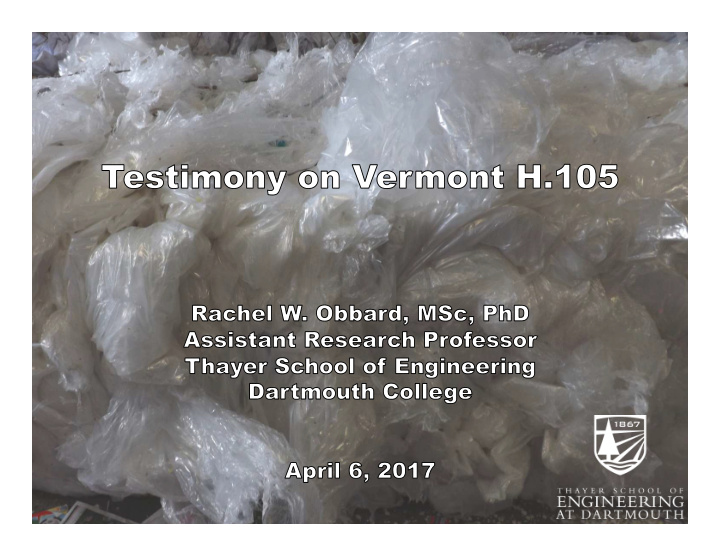



1
Our • About 330 million tons of plas4c were produced in 2016, of which about 37% was disposable packaging. • Plas4cs accumulate in the environment and are found in air seawater soil deep-sea sediments fresh water sea ice • Plas4cs make up 60-80% of marine liFer. • Polyethylene (PE), polypropylene (PP), and polystyrene (PS) are the major components of microplas4c debris in the ocean. • Single use carryout bags are most commonly PE. • PE can take more than 100 years to break down. 2
Plas4cs bags in the environment 3
Degrada4on ??? • Abio4c oxida4on by exposure to ultraviolet radia4on is the ini4al and rate-determining step for PE degrada4on in the environment. • Biodegradable plas4c bags contain addi4ves intended to hasten their chemical degrada4on in the presence of UV light. • Biofilms form on the surface of bags in the environment within weeks, and biofilms block as much as 90% of the transmiFed UV light, dras4cally slowing degrada4on. 4
Plas4c bags persist in the environment Ini4al amount of material (surface area) Amount remaining aWer 40 weeks in marine environment standard biodegradable compostable (e.g. cornstarch) bags bags bags 5 Source: O’Brine and Thompson, 2010
Degrada4on Fragmenta4on • Large plas4c items fragment over 4me into smaller pieces, which are more readily transported. • Microplas4cs are defined as plas4c debris <5 millimeters in size. • Microplas4c par4cles come from the breakdown of larger plas4c items, as well as from abrasives, exfoliants, cosme4cs, and pre-produc4on plas4c pellets. 6
A toxicological hazard • Chemicals used in manufacturing, or present in the environment, are sorbed by microplas4cs and released to organisms – phthalates – polychlorinated biphenyls (PCBs) – polycyclic aroma4c hydrocarbons (PAH) – organochloride pes4cides • PE sorbs an order of magnitude more phenanthrene (a PAH) than either polypropylene or PVC • PCBs are sorbed in far greater concentra4ons by PE and PP than by PET and PVC. 7
Marine animals ingest plas4c • Plas4c debris presents a hazard to a variety of animals. • More than 260 species including fish, seabirds, turtles, and marine mammals have been documented to become entangled in plas4cs or ingest them. • Inges4on can result in ulcera4on or starva4on. • In one study, PE and PP accounted for 97% of the total plas4c present in fur seal scat. • Turtles mistake plas4c bags for jellyfish. • Microplas4cs have been found in many commercial species of fish, mollusks, and crustaceans • Effects on human health are being examined 8
9
Plas4c bags on beaches produce anoxic (oxygen poor) microhabitats 10
Microplas4cs also found in freshwater ecosystems Less is know about the effects of plas4cs on freshwater systems, but research in this area is increasing. 11
Our problem, our solu4on ! • Goods are already very well packaged, do we really need a further disposable item of packaging to take them home in? • The single use plas4c carrier bag is a symbol of our throwaway society, and an unnecessary and avoidable use of plas4cs. • We need to retrain ourselves so that if we go out shopping it becomes as automa4c to take out a reusable bag with us as it would be to take a rain coat or an umbrella if it were raining. 12
Recommend